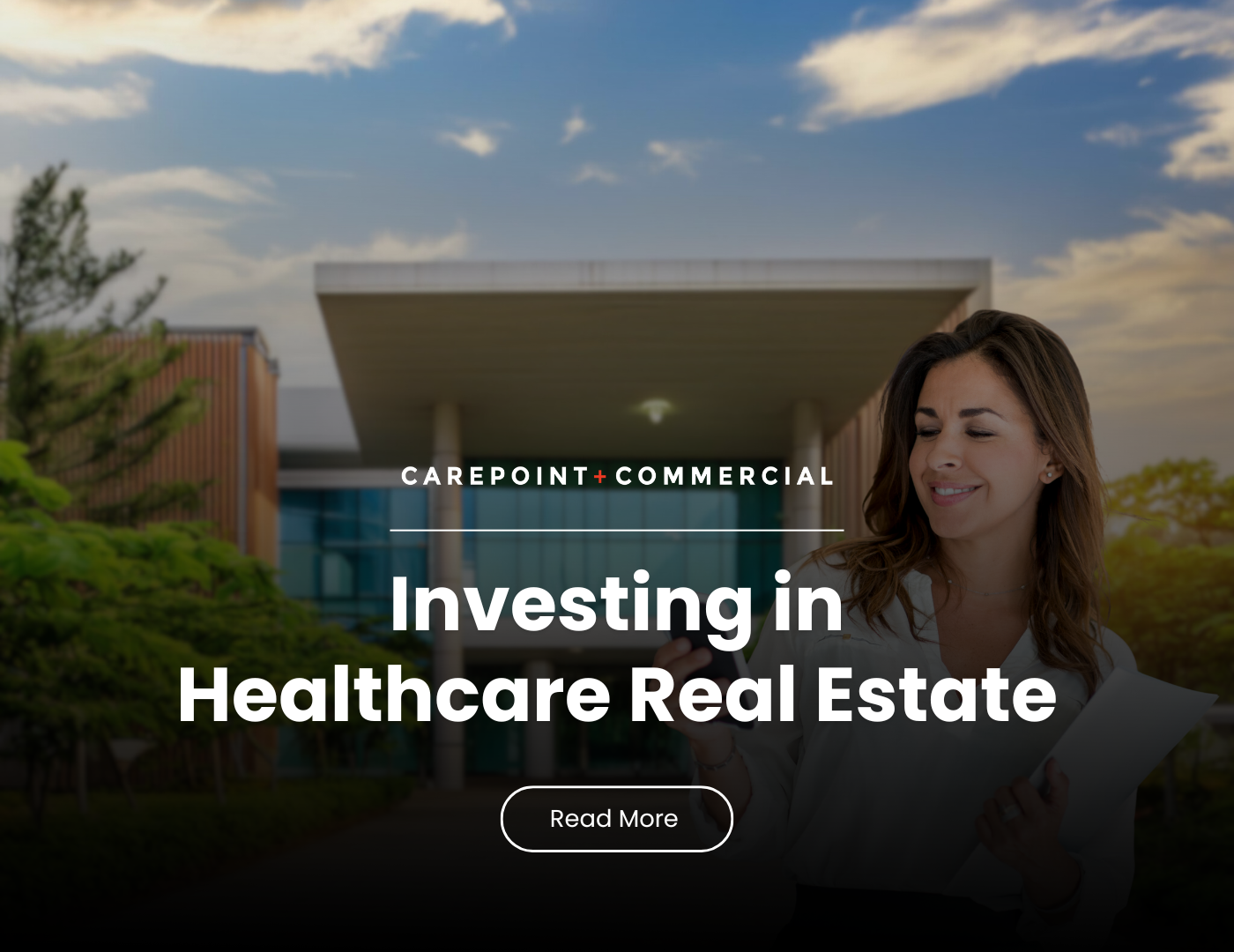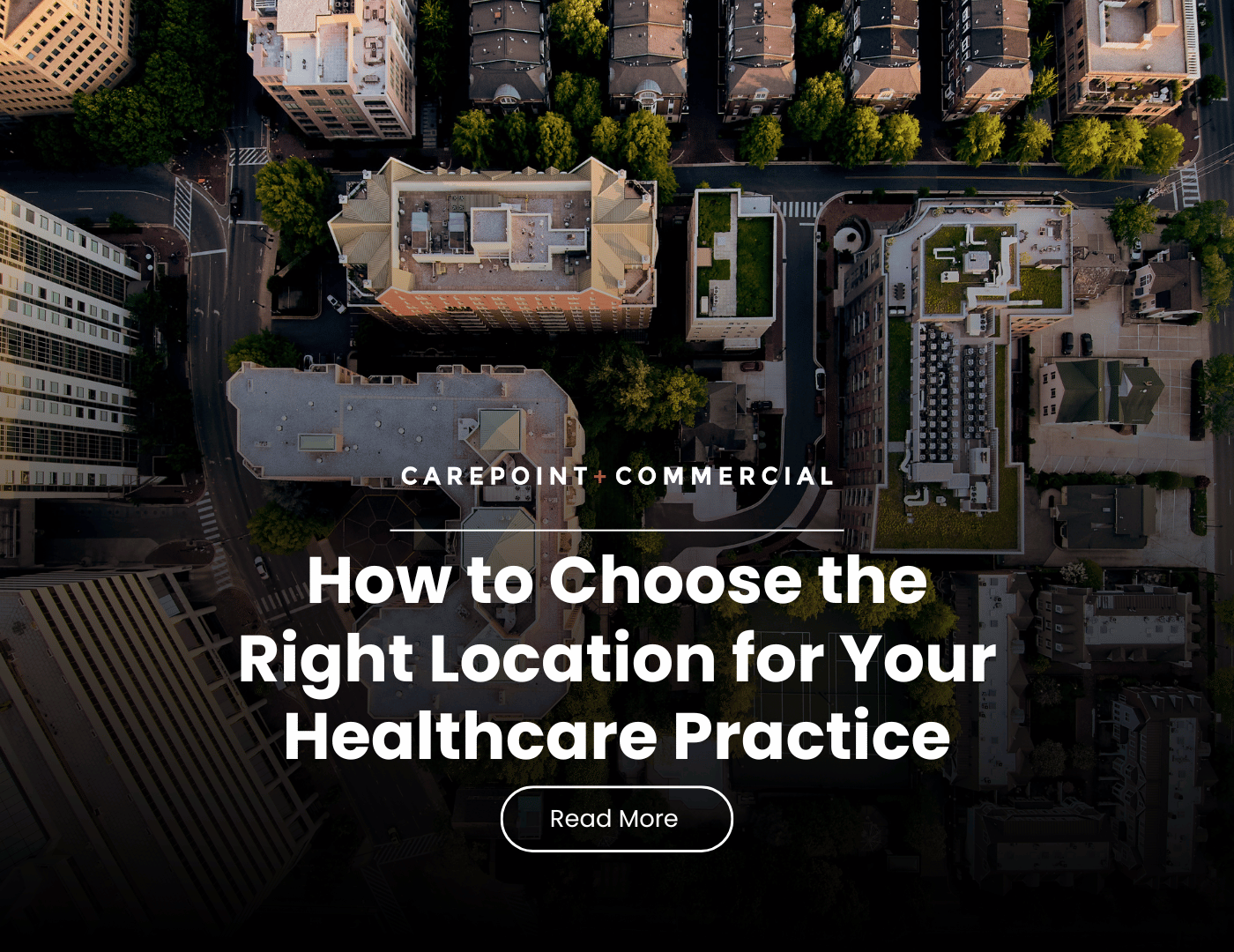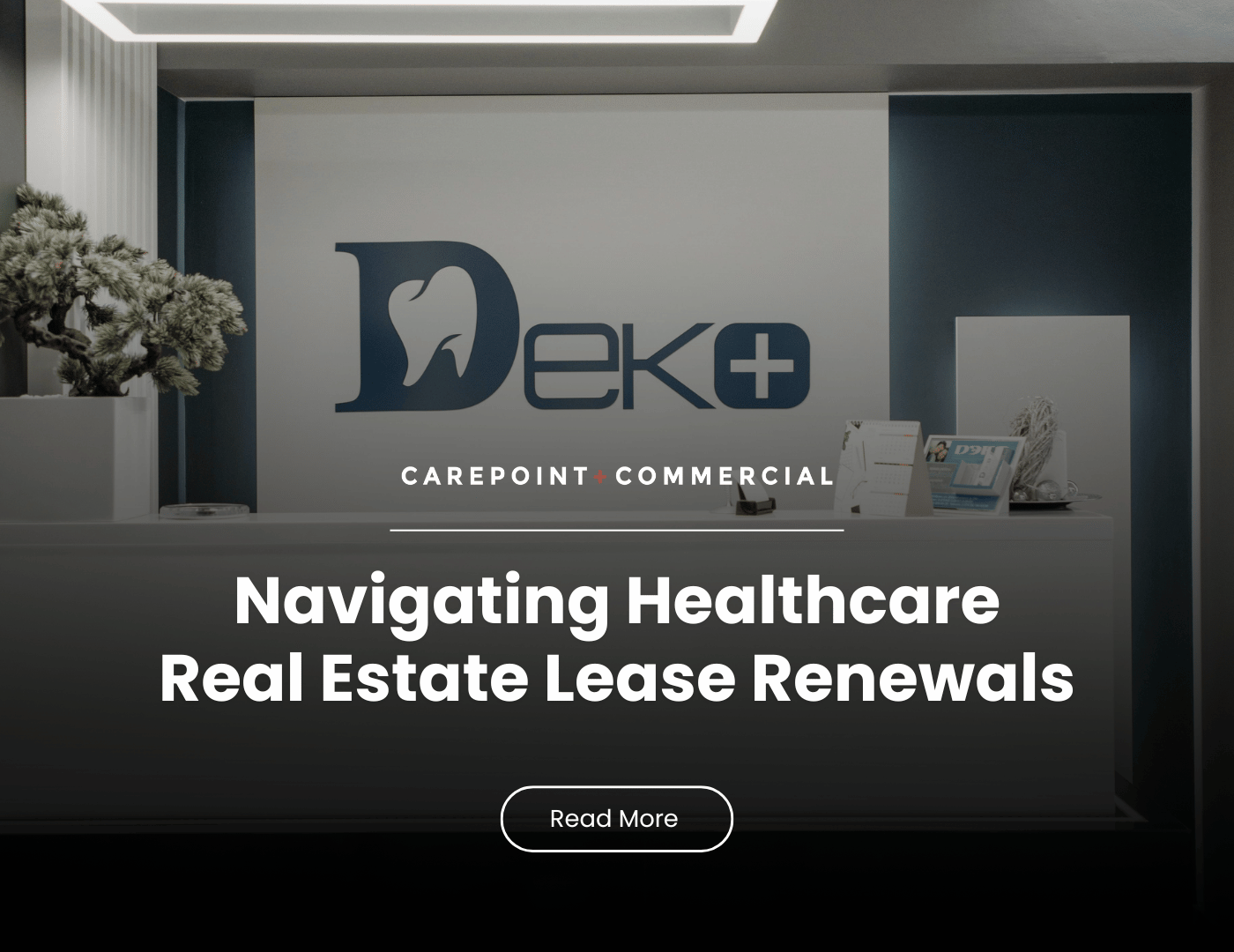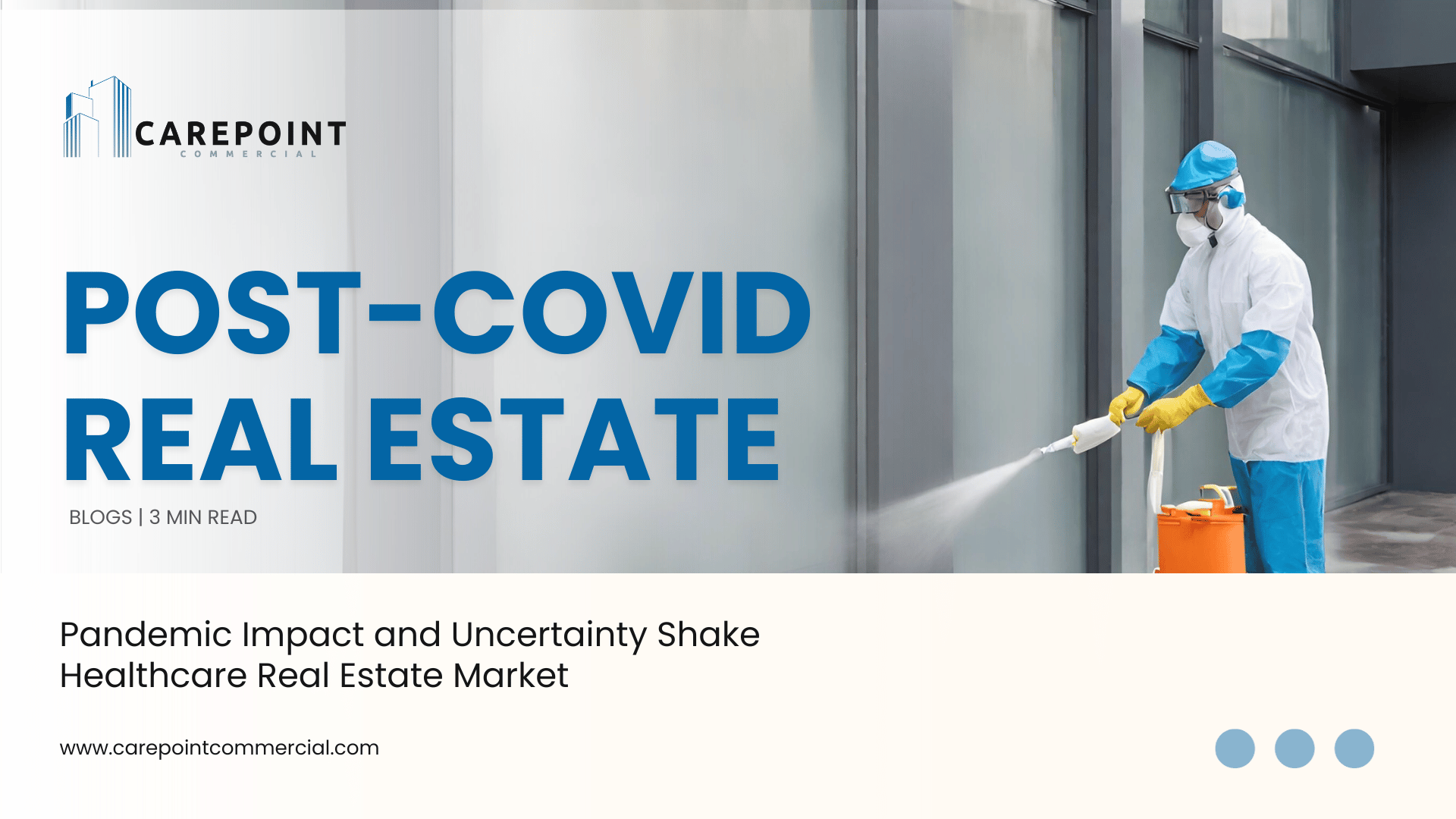Healthcare Real Estate: How to Choose the Right Location for Your Healthcare Practice
Healthcare real estate involves properties specifically designed for medical services, such as hospitals, outpatient facilities, medical office...
13 min read
![]() CarePoint Commercial Marketing
:
Jul 4, 2024 12:21:35 PM
CarePoint Commercial Marketing
:
Jul 4, 2024 12:21:35 PM

Healthcare real estate is a specialized sector that focuses on properties used for medical services, including hospitals, outpatient centers, and long-term care facilities. In this blog, we'll discuss how this market segment is experiencing growth parallel to that of the broader healthcare industry, driven by demographic changes and evolving medical practices. For investors, healthcare providers, and developers, it's crucial to understand the unique characteristics of this sector to succeed. As demand for healthcare services continues to rise, strategic investments and informed development in healthcare real estate are key to meeting community needs and ensuring the provision of high-quality care.
TL;DR: Healthcare real estate, encompassing hospitals, outpatient centers, and long-term care facilities, is experiencing expansion driven by demographic shifts and evolving medical practices. For investors, developers, and healthcare providers, a deep understanding of the unique aspects of this sector is essential to effectively capitalize on its growth opportunities.
Healthcare real estate is a specialized sector focusing on properties used for medical services, such as hospitals, outpatient centers, and long-term care facilities. This market segment is growing alongside the healthcare industry, driven by demographic changes and evolving medical practices. For investors, healthcare providers, and developers, understanding this sector's unique aspects is crucial for success.
The aging population is a major driver of healthcare real estate demand. As people age, their need for medical services increases, boosting the requirement for various healthcare facilities, including hospitals, specialized care centers, and assisted living facilities. Developers and investors need to consider these demographic trends and the specific needs of older adults when planning healthcare real estate projects.
Macroeconomic forecasts predict inflation will slow, but prices and interest rates will likely remain high. Healthcare systems, providers and investors have the opportunity to reassess their real estate footprint and organization and strategically optimize to generate new revenue.
Additionally, there's a noticeable shift towards outpatient care, spurred by advancements in medical technology and the push for cost efficiency. This change has led to a higher demand for smaller, flexible healthcare spaces such as urgent care and outpatient surgery centers that can be conveniently located near residential areas. These properties are increasingly attractive to real estate investors looking to diversify their portfolios.
Regulatory compliance also significantly impacts healthcare real estate. Facilities must adhere to numerous regulations ensuring patient safety and care quality, including building codes and health standards. Navigating these regulations is critical to avoid compliance issues and to ensure that healthcare properties meet all required standards.
Location is crucial in healthcare real estate. The success of a healthcare facility often depends on its proximity to densely populated areas, accessibility, and visibility. Properties near major transportation hubs or other medical facilities are typically more sought after. Furthermore, integrating healthcare facilities into mixed-use developments can enhance their appeal and create valuable synergies.
Healthcare systems are increasingly recognizing the strategic value of investing in real estate, driven by the goal to enhance service delivery and operational efficiency. This trend is influenced by multiple factors that connect healthcare delivery directly with real estate management.
A primary motivation for healthcare systems to invest in real estate is to improve patient care and accessibility. Owning facilities allows healthcare providers to strategically locate their operations in areas most accessible and convenient for their patient base, enhancing patient experience by reducing travel times and making visits more manageable. Additionally, owning their properties enables healthcare systems to tailor their facilities specifically to the demands of their services, optimizing the efficiency and effectiveness of care delivery.
Another critical reason for these investments is cost management. Real estate leasing is often a significant expense for healthcare providers, with costs fluctuating based on market conditions which can introduce financial instability. Ownership circumvents this, locking in long-term operational costs and shielding healthcare providers from the volatility of rental markets. This stability enables better financial planning and resource allocation, supporting the continued investment in advanced medical technologies and service expansion.
Operational flexibility is also a significant benefit of real estate ownership. Healthcare systems that own their properties can modify and expand their facilities as needed without the constraints of landlord agreements. This ability to adapt quickly to new healthcare regulations, technological advancements, and evolving patient care practices is vital for maintaining high standards of care and staying competitive in the healthcare sector.
Moreover, real estate ownership offers financial advantages beyond operational concerns. Properties held by healthcare systems typically appreciate in value, yielding substantial long-term financial returns. Furthermore, these assets provide an opportunity for additional revenue through leasing surplus space to other medical providers or related businesses, enhancing the financial robustness of the organization and funding further innovations and service improvements.
Healthcare systems invest in real estate not only to enhance the quality and accessibility of care but also to secure financial stability and operational flexibility. These investments are strategic, supporting the systems' long-term goals and enabling them to provide high-quality healthcare while adapting to an ever-evolving landscape. Understanding these benefits helps clarify why real estate is becoming a crucial component in the strategic planning of healthcare systems, poised to play an increasingly important role in their success.
For investors, healthcare professionals, and developers interested in this sector, it is crucial to understand the different types of properties that constitute healthcare real estate. This blog explores the primary property types prevalent within the healthcare system, highlighting their unique characteristics and roles.
Hospitals and Acute Care Facilities Hospitals and acute care facilities form the backbone of healthcare real estate. These institutions provide comprehensive medical services, ranging from emergency care to surgeries and specialized treatments for acute conditions. Hospitals are typically expansive, sophisticated buildings equipped with state-of-the-art medical technology and staffed by diverse healthcare professionals. Acute care facilities, often located within or near hospitals, concentrate on providing short-term treatment for patients with urgent health issues. The strategic design and placement of these facilities are essential to effectively serve large populations and uphold high care standards.
Medical Office Buildings (MOBs) Medical office buildings (MOBs) are crucial for housing outpatient services such as primary care, specialist consultations, diagnostic tests, and minor procedures. MOBs are designed for versatility to meet the varying requirements of different medical practices, allowing customization of spaces for specific healthcare providers. Frequently situated close to hospitals or in populous areas, MOBs facilitate easy patient access and are particularly appealing to investors due to their potential for stable, long-term rental income from reputable tenants.
Outpatient and Ambulatory Care Centers The rise of outpatient and ambulatory care centers aligns with the healthcare industry's shift towards more cost-effective, outpatient care models. These centers offer a spectrum of services that don’t require overnight stays, like preventive care, diagnostics, minor surgeries, and managing chronic conditions. Designed for operational efficiency and patient convenience, ambulatory care centers are smaller and less costly to run than hospitals, making them attractive to healthcare providers and investors aiming to capitalize on the increasing demand for outpatient services.
Long-Term Care and Assisted Living Facilities Addressing the needs of the aging population and individuals requiring prolonged care, long-term care, and assisted living facilities are increasingly vital. This category includes nursing homes, assisted living communities, and memory care centers, all designed to offer a supportive and comfortable living environment. These facilities often feature private or semi-private rooms, communal spaces, and specialized care services, with the demand driven by demographic trends such as the growing number of elderly needing sustained care. Investment in these properties generally promises stable and long-term returns due to the ongoing demand for senior care services.
Specialized Healthcare Facilities Lastly, specialized healthcare facilities cater to distinct medical fields and patient requirements, including urgent care centers, rehabilitation centers, and dialysis clinics. These facilities are equipped to provide focused treatments and services, requiring specific layouts and equipment to accommodate their operations. For instance, urgent care centers offer immediate treatment for non-life-threatening conditions, rehabilitation centers provide therapy services for recovery from surgeries or injuries, and dialysis clinics are crucial for patients with kidney disease. Each type of facility plays a pivotal role in a comprehensive healthcare ecosystem by meeting particular healthcare demands.
Understanding these varied property types within healthcare real estate is essential for stakeholders looking to navigate and succeed in this complex and ever-evolving market segment.
Maximizing the value of Medical Office Buildings (MOBs) requires a strategic approach that blends location optimization, tenant diversity, modern amenities, effective management, and proactive marketing. The location is critical; properties near hospitals, major healthcare facilities, and densely populated areas are more desirable, enhancing accessibility and convenience for patients and healthcare professionals. Investing in such prime locations, despite higher initial costs, can significantly increase tenant demand and property value appreciation.
A diverse tenant mix also plays a vital role in boosting an MOB's value. Incorporating a variety of healthcare providers, from primary care physicians and specialists to ancillary services like pharmacies and therapy centers, transforms an MOB into a comprehensive healthcare destination, increasing patient foot traffic and facilitating cross-referrals. Securing long-term leases with reputable providers ensures stable income and minimizes vacancies, while competitive lease terms and strong tenant relationships help attract and retain top-quality providers.
Moreover, modern facilities equipped with the latest technology are essential to attract high-caliber tenants and command higher rents. Upgrades supporting advanced medical equipment and telemedicine capabilities, along with amenities such as high-speed internet and secure data storage, increase the MOB's appeal. Ensuring compliance with the latest health and safety standards, including those related to COVID-19, reassures tenants and patients about the facility's quality.
Effective property management is crucial for maintaining and enhancing an MOB's value. A professional management team that addresses maintenance promptly, implements energy-efficient practices, and responds swiftly to tenant concerns plays a key role in maintaining the property’s condition and tenant satisfaction. Lastly, proactive marketing and community engagement enhance the MOB's visibility, attracting new tenants and patients. A strong online presence, coupled with hosting community health events and forming partnerships with local healthcare providers, establishes the MOB as a central healthcare hub.
By focusing on these strategic areas, investors and healthcare providers can enhance the appeal and profitability of their Medical Office Buildings, ensuring long-term success and value appreciation in a competitive market.
The role of a healthcare real estate advisor is crucial. These specialized consultants offer expert guidance to healthcare providers, investors, and developers, aligning real estate strategies with their operational and financial objectives. Understanding the comprehensive role of a healthcare real estate advisory is vital for navigating the sector's challenges and maximizing investment value.
A key function of healthcare real estate advisories is strategic planning and market analysis. They conduct in-depth market research to identify trends, opportunities, and risks, analyzing demographic shifts, competitive landscapes, and economic conditions. This enables informed decision-making for locating new facilities, expanding existing ones, or making strategic acquisitions, ensuring investments are poised to meet both current and future demands.
Financial analysis and funding strategy are also critical components of their services. Advisors assess the financial viability of projects through detailed cost-benefit analysis and ROI evaluation, helping to identify and secure funding from various sources such as banks, private equity, or other investment vehicles. Their expertise in deal structuring enhances the financial outcomes for their clients, supporting long-term financial stability.
Project management and implementation is another area where healthcare real estate advisors excel. They manage the entire development process from concept to completion, coordinating with architects, contractors, and stakeholders to ensure projects are delivered on time and within budget. Advisors navigate the complex regulatory landscape specific to healthcare facilities, ensuring compliance with relevant standards and laws, thus minimizing risks and enhancing project quality.
Tenant representation and lease negotiation are further areas where advisors deliver value. They negotiate on behalf of healthcare providers to secure favorable lease terms that support the providers' operational needs. Advisors handle lease renewals, expansions, and relocations, using their market knowledge to negotiate advantageous terms. This management of tenant-landlord relationships provides healthcare providers with essential flexibility and control over their real estate assets.
Lastly, healthcare real estate advisories offer asset management services to enhance the long-term value of real estate portfolios. They monitor property performance, identifying opportunities for cost reduction, revenue improvement, and strategic enhancements. Regular performance reports and market updates from advisors enable proactive decision-making, helping clients adapt to market shifts and maintain peak asset performance.
Leasing healthcare properties comes with unique challenges and requirements that distinguish it from other commercial real estate sectors. For healthcare providers seeking space and property owners looking for tenants, being aware of the crucial aspects of healthcare property leasing is key to a successful and beneficial arrangement. This blog delves into five essential factors to consider when leasing healthcare properties.
Compliance with Healthcare Regulations: Compliance with healthcare-specific regulations and standards is a primary concern in leasing healthcare properties. These facilities must adhere to strict guidelines related to patient safety, accessibility, and operational efficiency, which can vary widely depending on the region and medical specialty. This includes building codes, health and safety standards, and privacy laws. Both landlords and tenants need to collaborate to ensure the leased space complies with these regulations. Engaging legal and regulatory experts during lease negotiations can help in identifying and addressing potential compliance issues, avoiding expensive modifications and legal complications later on.
Facility Design and Infrastructure: The design and infrastructure of a healthcare facility are critical to its functionality for medical use. Specialized layouts are necessary, such as private examination rooms, advanced HVAC systems for infection control, and robust plumbing and electrical systems to support medical equipment. Prospective tenants must evaluate if the property meets their specific requirements or what changes will be needed. Landlords might need to invest in modifications to accommodate healthcare operations. These factors should be thoroughly discussed during the leasing process to ensure clarity and mutual understanding of any required modifications.
Lease Terms and Flexibility: Flexible and secure lease terms are vital for both parties in healthcare property leases. Healthcare providers generally prefer longer lease terms with renewal options to stabilize their operations given the substantial investment in setting up a medical practice. They also might need the flexibility to modify or expand the space as their practice evolves. Landlords should accommodate these requirements by offering adaptable lease terms that permit modifications and expansions. Clauses defining maintenance responsibilities, improvements, and compliance with healthcare standards can help in avoiding disputes and ensuring a seamless partnership.
Location and Accessibility: The success of a healthcare facility is significantly influenced by its location and accessibility. Properties near hospitals, major healthcare centers, and residential areas are usually more appealing to healthcare providers because of the convenience for patients and staff. Additionally, properties with excellent public transport access and ample parking are particularly attractive. Healthcare providers should consider patient demographics, proximity to other healthcare services, and the property’s visibility when choosing a location. Landlords can make their properties more desirable by emphasizing these location benefits and ensuring easy access for everyone.
Tenant Improvements and Customization: Customizing healthcare properties to meet the specific needs of medical practices often necessitates tenant improvements (TIs). These can range from simple modifications like installing medical-grade flooring to more extensive renovations for structural changes and equipment installations. During lease negotiations, it’s crucial to clarify who bears the costs and oversees these improvements. Agreements on TI allowances, approval processes, and execution timelines are essential for ensuring that the modifications meet the tenant's operational needs efficiently. Landlords who facilitate these customizations proactively are likely to attract and retain high-quality healthcare tenants.
Effective management of healthcare real estate assets is essential for healthcare providers and investors looking to optimize both the value and functionality of their properties in a sector that demands strategic insight to tackle unique challenges and seize opportunities within the dynamic healthcare industry.
One foundational aspect involves staying current with market trends and demographic shifts, such as population growth, aging demographics, and regional healthcare demands. Understanding these factors helps managers make informed decisions on property acquisitions, developments, or repurposing to align investments with market needs, maximizing asset value. For instance, regions with an aging population may have a growing demand for long-term care facilities, while urban areas with younger demographics might need more pediatric services.
Optimizing property utilization is also critical. This includes regular assessments of each property’s performance and functionality to ensure they meet the operational needs of healthcare providers. Strategies like implementing flexible layouts and shared spaces enhance efficiency and reduce costs, while adopting energy-efficient practices and technologies can lower operating expenses and contribute to sustainability goals. Regular audits and evaluations help identify underutilized areas and opportunities for improvement, ensuring that properties operate at their full potential.
The design and functionality of healthcare properties significantly impact the experience of both patients and staff. Modern, patient-friendly facilities with amenities such as comfortable waiting areas, advanced medical equipment, and straightforward navigation can improve patient satisfaction and outcomes. For staff, providing well-designed workspaces and support facilities can boost productivity and morale. Investing in renovations and upgrades that improve the overall environment is crucial, fostering a setting conducive to high-quality care and efficient operations.
Leasing and tenant management are also key components of effective healthcare real estate asset management. Developing strategic leasing plans that attract and retain high-quality tenants ensures stable, long-term income streams. Flexible lease agreements that allow tenants to expand or adapt their spaces as healthcare demands evolve are vital. Furthermore, maintaining strong relationships with tenants through regular communication and proactive support can prevent issues and foster a collaborative environment, enhancing occupancy rates and the overall success of the property.
Future-proofing healthcare real estate assets is crucial to ensure they remain relevant and valuable in a rapidly evolving industry. Designing and managing properties with flexibility and adaptability in mind allows for easy modifications and upgrades as healthcare technologies and practices change. Keeping abreast of technological advancements and regulatory updates ensures properties are prepared to accommodate future innovations and meet compliance requirements.
As we progress into 2024, the healthcare real estate sector continues to adapt to technological advancements, demographic shifts, and evolving healthcare delivery models. Investors, developers, and healthcare providers need to stay attuned to these changes to make strategic decisions that will shape the future of this industry. This blog post highlights five key trends that are expected to influence healthcare real estate throughout the year.
Increased Demand for Outpatient Facilities A significant trend in healthcare real estate is the escalating demand for outpatient facilities. With medical technology advancing and an emphasis on cost-effective care, many treatments and procedures have transitioned from inpatient to outpatient settings. This shift aims to reduce healthcare costs and enhance patient convenience. Consequently, there is a growing need for ambulatory surgery centers, urgent care clinics, and specialty outpatient centers. Investors and developers are now focusing on creating versatile, scalable spaces that can support a variety of outpatient services, optimizing both patient convenience and operational efficiency for healthcare providers.
Integration of Telehealth and Digital Health Technologies The integration of telehealth and digital health technologies into healthcare facilities is another trend poised to expand in 2024. Accelerated by the COVID-19 pandemic, the adoption of telehealth services is now a permanent aspect of the healthcare system. Consequently, medical office buildings and outpatient facilities are increasingly designed to include dedicated areas for telehealth consultations and remote patient monitoring. These spaces require robust digital infrastructure capable of supporting high-speed internet, secure data storage, and advanced communication systems. Real estate developers and healthcare providers are investing in technology-enhanced designs to meet the rising demand for virtual care services.
Focus on Sustainability and Wellness Sustainability and wellness are becoming pivotal themes in the development of healthcare real estate. More stakeholders recognize that healthcare facilities should promote overall well-being for patients, staff, and the community, not just provide medical care. In 2024, it's expected that more healthcare properties will incorporate sustainable building practices, such as using energy-efficient systems, green building materials, and waste reduction initiatives. Additionally, the architectural design of healthcare facilities is increasingly focusing on supporting mental and physical health through features like natural lighting, green spaces, and ergonomic design elements. These enhancements not only improve patient outcomes but also contribute to the long-term sustainability of healthcare properties.
Rise of Mixed-Use Developments Mixed-use developments that integrate healthcare facilities with residential, retail, and office spaces are on the rise. These developments foster integrated communities where healthcare services are easily accessible to residents and workers. By including healthcare facilities in mixed-use projects, developers can enhance property values and offer comprehensive services that cater to the needs of the community. For instance, a mixed-use development might feature a medical office building, a pharmacy, wellness centers, and health-related retail, along with apartments and commercial spaces. This model promotes accessibility and convenience, embedding healthcare services into daily life seamlessly.
Adaptive Reuse of Existing Properties Lastly, the adaptive reuse of existing properties is emerging as a cost-effective and sustainable strategy in healthcare real estate development. Rather than building new structures, developers are repurposing existing buildings—such as office buildings, retail spaces, and industrial sites—into modern healthcare facilities. Driven by the high costs of new construction and a desire to minimize environmental impact, adaptive reuse can be more economical and faster than new builds, allowing healthcare providers to quickly establish facilities in prime locations and effectively serve local communities.
By understanding and leveraging these trends, stakeholders in the healthcare real estate sector can enhance their strategic planning and investment decisions, ensuring their properties meet current demands and are well-positioned for future developments in healthcare delivery.
Healthcare real estate is a specialized market segment centered around properties designed for medical services, such as hospitals, outpatient centers, and long-term care facilities. This sector is expanding significantly, driven by demographic shifts and the evolution of medical practices.
For investors, healthcare providers, and developers, understanding the unique characteristics of this sector is crucial for success. As the demand for healthcare services increases, spurred by an aging population and advancements in medical technology, strategic investments and well-thought-out developments in healthcare real estate are essential. These efforts are key to addressing community needs and providing high-quality care.

Healthcare real estate involves properties specifically designed for medical services, such as hospitals, outpatient facilities, medical office...

A lease renewal extends the terms of an existing lease for an additional period, providing stability for tenants and steady income for landlords....

As the global pandemic continues to unsettle the commercial real estate landscape, the healthcare sector grapples with escalating challenges and...